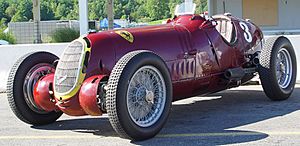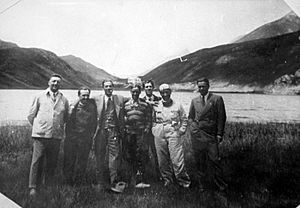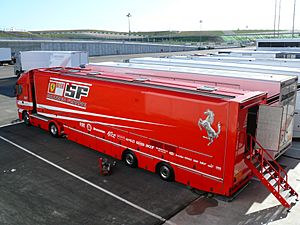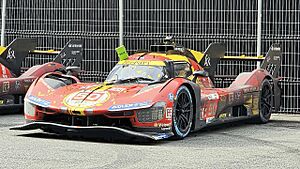Scuderia Ferrari facts for kids
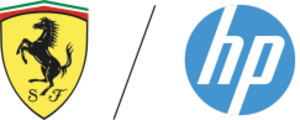 |
|
| Full name | Scuderia Ferrari HP |
|---|---|
| Base | Maranello, Modena, Italy 44°31′59″N 10°51′47″E / 44.533124°N 10.863097°E |
| Team principal(s) | Frédéric Vasseur Jérôme d'Ambrosio (Deputy Team Principal) |
| Technical Directors | Loïc Serra (Technical Director - Chassis) Diego Tondi (Head of Aerodynamics) Fabio Montecchi (Chief Project Engineer) Enrico Gualtieri (Technical Director - Power Unit) Diego Ioverno (Sporting Director) |
| Founder(s) | Enzo Ferrari |
| Formula One World Championship career | |
| First entry | 1950 Monaco Grand Prix |
| Last entry | 2025 Singapore Grand Prix |
| Races entered | 1010 (1007 starts) |
| Engines | Ferrari |
| Constructors' Championships |
16 (1961, 1964, 1975, 1976, 1977, 1979, 1982, 1983, 1999, 2000, 2001, 2002, 2003, 2004, 2007, 2008) |
| Drivers' Championships |
15 (1952, 1953, 1956, 1958, 1961, 1964, 1975, 1977, 1979, 2000, 2001, 2002, 2003, 2004, 2007) |
| Race victories | 237 |
| Podiums | 768 |
| Pole positions | 228 |
| Fastest laps | 253 |
| 2024 position | 2nd (652 pts) |
| Formula One World Championship career | |
|---|---|
| Engines | Ferrari, Jaguar |
| Entrants | Scuderia Ferrari, NART, numerous minor teams and privateers between 1950 and 1966 |
| First entry | 1950 Monaco Grand Prix |
| Last entry | 2025 Singapore Grand Prix |
| Races entered | 1010 (1008 starts) |
| Race victories | 238 |
| Constructors' Championships | 16 (1961, 1964, 1975, 1976, 1977, 1979, 1982, 1983, 1999, 2000, 2001, 2002, 2003, 2004, 2007, 2008) |
| Drivers' Championships |
15 (1952, 1953, 1956, 1958, 1961, 1964, 1975, 1977, 1979, 2000, 2001, 2002, 2003, 2004, 2007) |
| Points | WCC: 8388.5 WDC: 9290.27 |
| Pole positions | 228 |
| Fastest laps | 254 |
| Formula One World Championship career | |
|---|---|
| First entry | 1950 Monaco Grand Prix |
| Last entry | 2025 Singapore Grand Prix |
| Races entered | 1014 (1010 starts) |
| Chassis | Ferrari, Kurtis Kraft, Cooper, De Tomaso, Minardi, Dallara, Lola, Red Bull, Toro Rosso, Spyker, Force India, Sauber, Marussia, Haas, Alfa Romeo |
| Constructors' Championships | 16 (1961, 1964, 1975, 1976, 1977, 1979, 1982, 1983, 1999, 2000, 2001, 2002, 2003, 2004, 2007, 2008) |
| Drivers' Championships |
15 (1952, 1953, 1956, 1958, 1961, 1964, 1975, 1977, 1979, 2000, 2001, 2002, 2003, 2004, 2007) |
| Race victories | 239 |
| Podiums | 779 |
| Points | WCC: 9273.5 WDC: 9866.29 |
| Pole positions | 229 |
| Fastest laps | 260 |
Scuderia Ferrari is the famous racing team of the luxury Italian car maker Ferrari. They are best known for competing in Formula One racing. The team is often called "the Prancing Horse" because of their special horse logo. Ferrari is the oldest and most successful team in Formula One. They have raced in every World Championship since 1950.
The team was started by Enzo Ferrari in 1929. At first, they raced cars made by Alfa Romeo. By 1947, Ferrari began building their own cars. Outside of Formula One, Ferrari has won many other important races. These include the World Sportscar Championship and famous endurance races like the 24 Hours of Le Mans. Fans of Ferrari are known as the tifosi, and they are very passionate. The Italian Grand Prix at Monza is like a home race for the team.
In Formula One, Ferrari holds the record for the most Constructors' Championships with 16 wins. Their last Constructors' Championship was in 2008. They also have the most Drivers' Championships with 15 titles. Nine different drivers have won these titles for Ferrari. These champions include Alberto Ascari, Juan Manuel Fangio, Niki Lauda, and Michael Schumacher. Kimi Räikkönen won the team's most recent Drivers' title in 2007. Ferrari celebrated their 1000th Grand Prix race in Formula One at the 2020 Tuscan Grand Prix.
Michael Schumacher is Ferrari's most successful driver. He raced for them from 1996 to 2006. During this time, he won five Drivers' titles in a row. He also won 72 Grand Prix races for the team. His titles were from 2000 to 2004. The team also won many Constructors' titles during this period. This was the most successful time in Ferrari's history. For the 2025 season, Ferrari's drivers are Charles Leclerc and seven-time Formula One World Champion Lewis Hamilton.
Team History
Scuderia Ferrari was started by Enzo Ferrari in 1929. He wanted to help amateur drivers race. Before this, Enzo Ferrari raced cars himself. The idea for the team came during a dinner in Bologna. Ferrari got financial help from some wealthy friends. He then built a team with over forty drivers. Most of them raced in Alfa Romeo 8C cars. Enzo Ferrari stopped racing in 1932 when his first son, Dino, was born. The famous prancing horse logo first appeared in 1932. It was on two Alfa Romeo 8C cars at the Spa 24 Hours race in Belgium. Those cars finished first and second.
In 1933, Alfa Romeo faced money problems and stopped their own racing team. Scuderia Ferrari then became Alfa Romeo's main racing team. They even used Alfa Romeo's latest race cars. In 1935, Enzo Ferrari and Luigi Bazzi built the Alfa Romeo Bimotore. This was the first car to have a Ferrari badge on its front. Ferrari managed many famous drivers like Tazio Nuvolari and Louis Chiron. He worked from his office in Modena, Italy. In 1938, Alfa Romeo made him the manager of their factory racing team, Alfa Corse.
Enzo Ferrari did not agree with Alfa Romeo's new plans. He left Alfa Romeo in 1939. In October 1939, he started his own company, Auto Avio Costruzioni Ferrari. This company also made machine tools. Part of his agreement with Alfa Romeo was that he could not use the Ferrari name on cars for four years. In 1939–1940, Ferrari began working on his own race car, the Tipo 815. These were the first real Ferrari cars. After the 1940 Mille Miglia race, World War II stopped racing for a while. Ferrari continued making machine tools. In 1943, he moved his company to Maranello. The factory was bombed in 1944 and 1945.
After the war, rules for a Grand Prix World Championship were set up. Ferrari rebuilt his factory in Maranello. He built the Tipo 125 car. This car raced in several non-championship Grand Prix events. It debuted in 1948 and won its first race with Giuseppe Farina. After the four-year ban on the Ferrari name ended, the road car company became Ferrari S.p.A.. The racing part was called SEFAC.
Team Headquarters
The team was first based in Modena until 1943. That year, Enzo Ferrari moved the team to a new factory in Maranello. Both Scuderia Ferrari and the Ferrari road car factory are still in Maranello today. The team also has its own test track there, called the Fiorano Circuit. It was built in 1972 and is used to test both road and race cars.
Team Identity
The team is named after its founder, Enzo Ferrari. Scuderia is an Italian word for a stable where racing horses are kept. It is often used for Italian motor racing teams. The prancing horse logo was first used by Francesco Baracca. He was an Italian pilot in World War I. His parents, who knew Enzo Ferrari, suggested he use the symbol. They told him it would "bring him good luck."
Formula One Racing
Since their first race in 1950, Ferrari has become a symbol of Formula One. For many, Ferrari and Formula One racing are connected. Ferrari is the only team that has raced in every season since the World Championship began.
Engine Supply
Ferrari makes engines for its own Formula One cars. They have also supplied engines to other teams. Some teams that have used Ferrari engines include Minardi (1991), Sauber (1997–2005, 2010–2025), Red Bull Racing (2006), and Scuderia Toro Rosso (2007–2013, 2016). For the 2025 season, Ferrari supplies engines to the Haas F1 Team and Sauber Motorsport. Ferrari also announced that the new Cadillac Formula One team will use their engines and gearboxes from 2026.
Team Orders in Racing
Team orders have sometimes caused arguments in Ferrari's history. In the 1982 San Marino Grand Prix, Ferrari drivers Gilles Villeneuve and Didier Pironi were leading. The team showed a "slow" sign, meaning the leading driver should win. Villeneuve slowed down, expecting Pironi to follow. But Pironi passed him instead. Villeneuve was very upset. This event may have contributed to his fatal accident in the next race.
At the 2002 Austrian Grand Prix, Rubens Barrichello was leading for Ferrari. He was told to let his teammate Michael Schumacher pass him. This made many fans and the FIA (the sport's governing body) unhappy. After this and other similar events, team orders were banned in Formula One for the 2003 season.
In 2010, at the 2010 German Grand Prix, Fernando Alonso passed Felipe Massa for the lead. Ferrari had told Massa that Alonso was "faster than him." Many people saw this as a team order. Ferrari was fined $100,000 for breaking the rules. The ban on team orders was later lifted for the 2011 season.
Racing Colours
Ferrari's racing cars have almost always been red. This is because rosso corsa (racing red) is the traditional national racing colour of Italy. There were two exceptions in 1964. Enzo Ferrari let his cars be entered by the NART in white with blue stripes. This was a protest against Italian racing authorities. However, Ferrari won the 1964 World Championship with John Surtees using these white and blue cars. Since the 1964 Mexican Grand Prix, Ferrari cars have always raced in their traditional red colour in Formula One.
Team Sponsorships
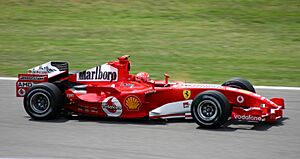
For many years, the Ferrari Formula One team did not have many commercial sponsors. It was not until 1977 that the cars showed the logo of the Fiat group, who owned Ferrari. Before the 1980s, only technical partners like Magneti Marelli and Shell had their logos on the cars. In 1997, Philip Morris International (through its brand Marlboro) became Ferrari's main sponsor. The team's official name changed to Scuderia Ferrari Marlboro. This lasted until 2011.
In some races, like the United States Grand Prix, Ferrari had to use non-tobacco designs on their cars. This was due to rules about tobacco advertising. Even after tobacco advertising became illegal in the European Union, Ferrari continued its deal with Philip Morris. The last time Ferrari had clear tobacco sponsorship on the car was in 2007. After that, they used barcodes and other hidden symbols.
In 2018, Ferrari added logos for Philip Morris International's "Mission Winnow" project. This project was described as being about "science, technology and innovation." However, some people noticed that the logos looked like the Marlboro cigarette packet design. In 2019, Mission Winnow became the team's main sponsor. But the logos were removed for some races after authorities investigated if it broke tobacco advertising laws. The Mission Winnow sponsorship ended at the end of the 2021 season.
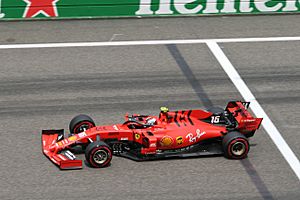
On September 10, 2009, Ferrari announced a five-year sponsorship deal with Santander. This deal was extended until late 2017. Santander and Ferrari renewed their partnership in December 2021. Other sponsors have included Acer (who sold Ferrari-branded laptops) and AMD (a computer chip maker). In 2014, Ferrari also signed a deal with Haas Automation. This led to the Haas F1 Team entering Formula One in 2016 using Ferrari engines.
In April 2018, AMD returned as a sponsor. In December 2021, Ferrari extended its partnership with Kaspersky Lab. However, this deal ended after the 2022 conflict in Ukraine. For the 2021 season, Ferrari had many official suppliers and sponsors. These included Pirelli, Puma, Shell, Ray-Ban, and United Parcel Service. On April 24, 2024, Ferrari announced a new partnership with HP Inc.. The team is now called Scuderia Ferrari HP.
Other Racing Series
Formula Two Racing
Ferrari also competed in the Formula 2 series in different years:
- 1948–1951: 166 F2
- 1951–1953: 500 F2
- 1953: 553 F2
- 1957–1960: Dino 156 F2
- 1967–1969: Dino 166 F2
Sportscar Racing Success
From the late 1940s to the early 1970s, Ferrari was very successful in sports car racing. They won the World Sportscar Championship (WSC) twelve times. Ferrari cars won the Mille Miglia eight times and the 24 Hours of Le Mans nine times. During this time, Ferrari was one of the few car makers to compete in both Formula One and endurance racing. They achieved great success with limited resources. This showed the skill and passion of the Scuderia team and Enzo Ferrari.
Ferrari started winning in sports car racing very early. They won the Mille Miglia and Targa Florio in 1948. In 1949, they won the Mille Miglia, 24 Hours of Le Mans, and other major races. These wins were with the 2-litre Ferrari 166 MM car. This car was famous for its design and was copied by others. Ferrari cars became known for excellence, and rich people wanted to buy them.
-
1949 Mille Miglia and Le Mans-winning Ferrari 166 MM
Ferrari continued its winning streak in the following years. They won the Carrera Panamericana in 1951 and the Mille Miglia in 1950 and 1951. At the same time, Ferrari also started winning in Formula One. In 1953, the WSC was created. Ferrari, along with other car makers, began entering many factory-backed cars in races. These included the 24 Hours of Le Mans and the Mille Miglia. Ferrari released many sports cars during this time. With these powerful cars, Ferrari won six of the first seven WSC titles (1953, 1954, 1956, 1957, and 1958).
-
The Willy Mairesse / John Surtees Ferrari 250 P winning at the 1963 1000 km Nürburgring.
-
Ferrari 275 P driven by Ludovico Scarfiotti at the 1964 1000 km Nürburgring.
In the early 1960s, Ferrari continued to be very successful. They won the 24 Hours of Le Mans six times in a row (from 1960 to 1965). They developed the Ferrari P series of cars. Until 1964, they faced little competition from other major car makers. At the end of 1963, there was a disagreement between Ferrari and Ford. Ford wanted to buy Ferrari. This led to the famous "Ford vs. Ferrari war." Ford decided to enter endurance racing and spent a lot of money. They developed the Ford GT40 car. Ford engines later dominated Formula One for over ten years. Ferrari won in 1964 and 1965, but Ford won the 1966 championship and Le Mans race.
In 1967, Ferrari won the championship but lost at Le Mans. A change in rules for 1968 forced Ferrari to leave the championship. This ended the Ford vs. Ferrari battle in endurance racing. The 1970s was the last decade Ferrari raced as a factory team in sports car racing. After a difficult 1973 season, Enzo Ferrari stopped developing sports cars. He wanted to focus only on Formula One. This decision helped Ferrari win several Formula One titles in the following years. Ferrari cars were still raced by other teams in GT racing. In the 1990s, Ferrari returned to sports prototypes with the Ferrari 333 SP.
Since 2006, Ferrari has returned to GT car racing. They work with racing teams like AF Corse. These teams have had great success in GT competitions. AF Corse has won many GT titles in the FIA GT Championship and the FIA World Endurance Championship (WEC). Ferrari/AF Corse won seven out of ten GT manufacturers' championships in the WEC. They also won many GT drivers' titles. Other victories include two GT2 class wins at the 24 Hours of Le Mans in 2008 and 2009. AF Corse also won four GTE Pro class wins at Le Mans. A Ferrari 488 GT3 won the 2017 12 Hours of Bathurst and the 2021 24 Hours of Spa.
In 2023, after 50 years, Ferrari returned to the top class of endurance racing. They used their new Ferrari 499P car. This car is a Le Mans Hypercar prototype. They competed for the world title and in big events like the 24 Hours of Le Mans. At the 2023 24 Hours of Le Mans, Ferrari won their first Le Mans victory since 1965. The No. 51 499P car won with drivers Alessandro Pier Guidi, James Calado, and Antonio Giovinazzi. In the same year, a Ferrari 296 GT3 won the 24 Hours of Nürburgring. At the 2024 24 Hours of Le Mans, Ferrari won again. The No. 50 499P car won with drivers Antonio Fuoco, Miguel Molina, and Nicklas Nielsen. This was Ferrari's eleventh victory at Le Mans.
Team Statistics and Records
Formula One Achievements
Ferrari has achieved amazing success in Formula One. Here are some of their records:
- Constructors' Championship winning percentage: 16 wins out of 67 seasons (23.9%)
- Drivers' Championship winning percentage: 15 wins out of 75 seasons (20%)
- Winning percentage: 245 wins out of 1099 entries (22.3%)
Ferrari is also the most successful Formula One engine manufacturer. They have 246 wins. This includes one win by Scuderia Toro Rosso in 2008 and one private Ferrari win in 1961.
| Record | As a team | As a constructor |
|---|---|---|
| Most Constructors' Championships | 16 | 16 |
| Most Drivers' Championships | 15 | 15 |
| Most Grands Prix participated | 1010 | 1010 |
| Most Grands Prix started | 1007 | 1008 |
| Most wins | 237 | 238 |
| Most podium finishes | 768 (in -3 races) | 773 (in races) |
| Most 1–2 finishes | 86 | 87 |
| Most pole positions | 228 | 228 |
| Most fastest laps | 253 | 254 |
| Most laps led | 16016 | 16023 |
| Most Constructors' Championship points | 8388.5 | |
| Most Drivers' Championship points | 9290.27 |
Drivers' Champions for Ferrari
Nine different drivers have won the Drivers' Championship while racing for Ferrari. They have won a total of fifteen titles:
 Alberto Ascari (1952, 1953)
Alberto Ascari (1952, 1953) Juan Manuel Fangio (1956)
Juan Manuel Fangio (1956) Mike Hawthorn (1958)
Mike Hawthorn (1958) Phil Hill (1961)
Phil Hill (1961) John Surtees (1964)
John Surtees (1964) Niki Lauda (1975, 1977)
Niki Lauda (1975, 1977) Jody Scheckter (1979)
Jody Scheckter (1979) Michael Schumacher (2000, 2001, 2002, 2003, 2004)
Michael Schumacher (2000, 2001, 2002, 2003, 2004) Kimi Räikkönen (2007)
Kimi Räikkönen (2007)
Team Principals and Sporting Directors
Here is a list of the leaders of the Ferrari Formula One team:
 Federico Giberti (1950–1951)
Federico Giberti (1950–1951) Nello Ugolini (1952–1955)
Nello Ugolini (1952–1955) Eraldo Sculati (1956)
Eraldo Sculati (1956) Mino Amorotti (1957)
Mino Amorotti (1957) Romolo Tavoni (1958–1961)
Romolo Tavoni (1958–1961) Eugenio Dragoni (1962–1966)
Eugenio Dragoni (1962–1966) Franco Lini (1967)
Franco Lini (1967) Franco Gozzi (1968–1970)
Franco Gozzi (1968–1970) Peter Schetty (1971–1972)
Peter Schetty (1971–1972) Alessandro Colombo (1973)
Alessandro Colombo (1973) Luca Cordero di Montezemolo (1974–1975)
Luca Cordero di Montezemolo (1974–1975) Daniele Audetto (1976)
Daniele Audetto (1976) Roberto Nosetto (1977)
Roberto Nosetto (1977) Marco Piccinini (1978–1988)
Marco Piccinini (1978–1988) Cesare Fiorio (1989–1991)
Cesare Fiorio (1989–1991) Claudio Lombardi (1991)
Claudio Lombardi (1991) Sante Ghedini (1992–1993)
Sante Ghedini (1992–1993) Jean Todt (1993–2007)
Jean Todt (1993–2007) Stefano Domenicali (2008–2014)
Stefano Domenicali (2008–2014) Marco Mattiacci (2014)
Marco Mattiacci (2014) Maurizio Arrivabene (2015–2018)
Maurizio Arrivabene (2015–2018) Mattia Binotto (2019–2022)
Mattia Binotto (2019–2022) Frédéric Vasseur (since 2023)
Frédéric Vasseur (since 2023)
Ferrari Engines for Other Teams
Ferrari has supplied engines to many other Formula One teams over the years.
| Constructor | Season(s) | Win(s) | Pole position(s) | Fastest lap(s) | First win | Last win |
|---|---|---|---|---|---|---|
| 1950–present | 238 | 228 | 254 | 1951 British Grand Prix | 2024 Mexico City Grand Prix | |
| 1956 | 0 | 0 | 0 | — | — | |
| 1960, 1966 | 0 | 0 | 0 | — | — | |
| 1963 | 0 | 0 | 0 | — | — | |
| 1991 | 0 | 0 | 0 | — | — | |
| 1992–1993 | 0 | 0 | 0 | — | — | |
| 2006 | 0 | 0 | 0 | — | — | |
| 2007 | 0 | 0 | 0 | — | — | |
| 2007–2013, 2016 | 1 | 1 | 1 | 2008 Italian Grand Prix | 2008 Italian Grand Prix | |
| 2008 | 0 | 0 | 0 | — | — | |
| 2010–2018, 2024–2025 | 0 | 0 | 3 | — | — | |
| 2014–2015 | 0 | 0 | 0 | — | — | |
| 2016–present | 0 | 0 | 2 | — | — | |
| 2019–2023 | 0 | 0 | 0 | — | — | |
| Total | 1950–present | 239 | 229 | 260 |
Esports Drivers' Champions
One driver has won the Formula One Esports Drivers' Championship for Scuderia Ferrari Esports Team:
See also
 In Spanish: Scuderia Ferrari para niños
In Spanish: Scuderia Ferrari para niños
- List of Ferrari engines
- List of Ferrari road cars
- Museo Ferrari


